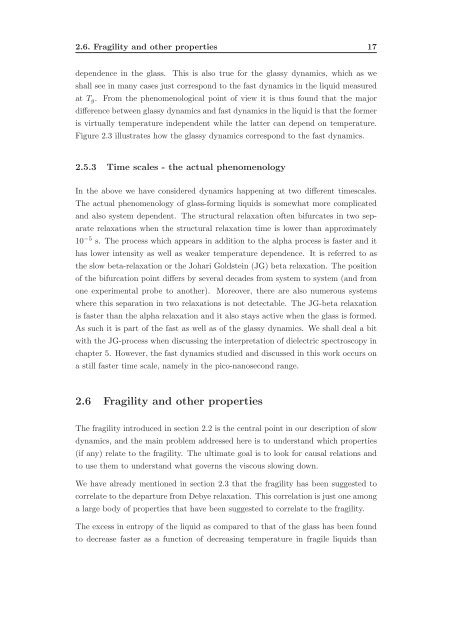Ph.D. thesis (pdf) - dirac
Ph.D. thesis (pdf) - dirac
Ph.D. thesis (pdf) - dirac
You also want an ePaper? Increase the reach of your titles
YUMPU automatically turns print PDFs into web optimized ePapers that Google loves.
2.6. Fragility and other properties 17<br />
dependence in the glass. This is also true for the glassy dynamics, which as we<br />
shall see in many cases just correspond to the fast dynamics in the liquid measured<br />
at T g . From the phenomenological point of view it is thus found that the major<br />
difference between glassy dynamics and fast dynamics in the liquid is that the former<br />
is virtually temperature independent while the latter can depend on temperature.<br />
Figure 2.3 illustrates how the glassy dynamics correspond to the fast dynamics.<br />
2.5.3 Time scales - the actual phenomenology<br />
In the above we have considered dynamics happening at two different timescales.<br />
The actual phenomenology of glass-forming liquids is somewhat more complicated<br />
and also system dependent. The structural relaxation often bifurcates in two separate<br />
relaxations when the structural relaxation time is lower than approximately<br />
10 −5 s. The process which appears in addition to the alpha process is faster and it<br />
has lower intensity as well as weaker temperature dependence. It is referred to as<br />
the slow beta-relaxation or the Johari Goldstein (JG) beta relaxation. The position<br />
of the bifurcation point differs by several decades from system to system (and from<br />
one experimental probe to another). Moreover, there are also numerous systems<br />
where this separation in two relaxations is not detectable. The JG-beta relaxation<br />
is faster than the alpha relaxation and it also stays active when the glass is formed.<br />
As such it is part of the fast as well as of the glassy dynamics. We shall deal a bit<br />
with the JG-process when discussing the interpretation of dielectric spectroscopy in<br />
chapter 5. However, the fast dynamics studied and discussed in this work occurs on<br />
a still faster time scale, namely in the pico-nanosecond range.<br />
2.6 Fragility and other properties<br />
The fragility introduced in section 2.2 is the central point in our description of slow<br />
dynamics, and the main problem addressed here is to understand which properties<br />
(if any) relate to the fragility. The ultimate goal is to look for causal relations and<br />
to use them to understand what governs the viscous slowing down.<br />
We have already mentioned in section 2.3 that the fragility has been suggested to<br />
correlate to the departure from Debye relaxation. This correlation is just one among<br />
a large body of properties that have been suggested to correlate to the fragility.<br />
The excess in entropy of the liquid as compared to that of the glass has been found<br />
to decrease faster as a function of decreasing temperature in fragile liquids than

















